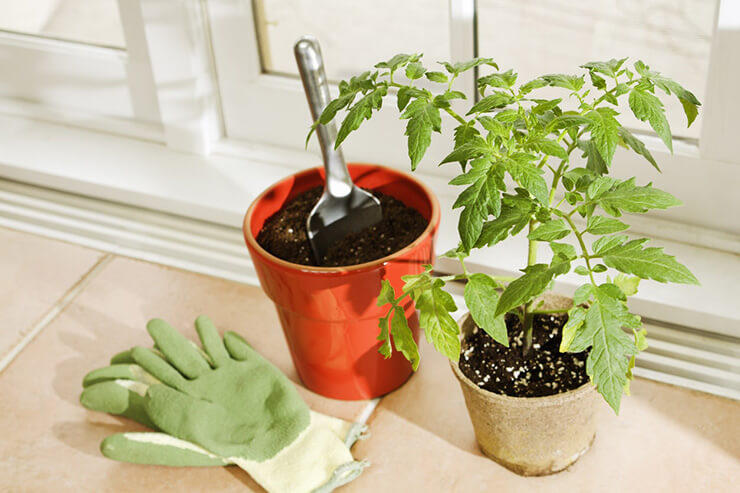Whether you’re growing herbs in a kitchen window or even strawberries under grow lights, understanding a few key principles can turn your indoor garden into a lush, productive, and flavorful sanctuary.

Consider Your Conditions
Start by evaluating your environment:
- Light: Do you have sunny south-facing windows? Shady corners? Both?
- Humidity: Is your home dry due to heating or air-conditioning?
- Temperature: Is your space drafty or consistently warm?
Match your plant choices to these conditions. For example:
- Low-light lovers: Mushrooms
- Humidity fans: Some herbs, like basil
- Sun seekers: Tomatoes, citrus trees
Think About Your Time Commitment
Busy schedule? Pick a plant that will tolerate some benign neglect. Green onions, lettuce, and herbs like basil or rosemary might be a good place to start.
Understanding Light
Light is food for plants—it drives photosynthesis. But not all plants need the same amount.
Natural Light
Plants are typically labeled by light needs:
- Full sun (6+ hours/day): Ideal for fruiting veggies like tomatoes and peppers
- Bright, indirect light: Best for most houseplants, leafy greens, and herbs
- Low light: Great for mushrooms
Observe how light moves through your space during the day. South-facing windows offer the most consistent sun. East-facing windows provide gentle morning light, while west-facing ones give stronger afternoon sun. North-facing windows offer the least.
Supplemental Lighting
If your home lacks sufficient natural light—or you’re growing in Winter—LED grow lights are a game-changer. Choose full-spectrum bulbs and use timers to maintain consistent light cycles, typically 14-16 hours/day for edible plants.
Watering Wisely
Overwatering is one of the most common reasons indoor plants struggle. Learning your plant’s watering rhythm is essential.
General Rules of Thumb
- Check the top inch of soil. If it’s dry, it’s usually time to water.
- Use room-temperature water to avoid shocking the roots.
- Water deeply but infrequently, allowing excess to drain fully.
Drainage Is Key
Make sure your pots have drainage holes. Soggy roots lead to rot. Use trays or saucers to catch overflow but don’t let plants sit in water.
Different plants have different needs. Check each plant’s requirements to ensure you’re watering properly.
Feeding and Fertilizing
Plants need nutrients to grow, especially when you’re growing food. Over time, soil nutrients get depleted in containers.
Fertilizer Types
- Liquid fertilizersare easy to apply during watering.
- Slow-release pelletsoffer nutrients over weeks or months.
- Organic optionsinclude compost tea, worm castings, or seaweed extract.
Feeding Schedule
Most indoor plants benefit from feeding every 4-6 weeks during the growing season (Spring through early Fall). Reduce or pause fertilizing in Winter when growth slows. Overfertilizing can shift energy to leaf growth at the expense of your food crop; be sure to check each plant’s requirements so you get the balance just right.
Selecting Soil and Containers
Indoor gardening success depends on the right growing medium and pot setup.
Choose the Right Soil
Not all soil is created equal. Follow the guidelines on your seed packets or ask for advice at your local garden center. And avoid using outdoor soil indoors—it can compact in pots and harbor pests. You’re much better off getting fresh, pest-free potting soil that’s appropriate for what you’re growing.
Pick Proper Containers
- Always choose pots with drainage holes.
- Plastic and ceramicretain moisture longer.
- Terracottadries out faster.
You can grow in repurposed containers—just be sure they’re clean, non-toxic, and allow for drainage.
Humidity and Airflow
Indoor air—especially during heating season—can be dry. Some plants, like microgreens or citrus, need more humidity to thrive.
Boost Humidity Indoors
- Group plants togetherto create a microclimate.
- Use humidifiers, especially near tropical plants like citrus.
- Set pots on trays filled with water and pebbles
- Mist leaves occasionally (but avoid soggy conditions)
Remember: plants naturally slow down during shorter days. Don’t panic if growth
pauses—it’s part of the cycle.
Good air circulation is also crucial. It prevents mold and strengthens stems:
- Use a small fan on a low setting near dense arrangements.
- Avoid stagnant, enclosed corners without airflow.
Cleaning Leaves
Dust can block light. Wipe broad leaves gently with a damp cloth or give plants a light shower in the sink or tub as needed.
Watching for Pests and Diseases
Even indoor plants can attract pests, although problems are usually less severe than outdoors.
Common Indoor Pests
- Spider mites: Fine webs and tiny moving dots on leaves
- Fungus gnats: Small flies hovering near soil
- Mealybugs: White, cottony clusters on stems
Prevention and Control
- Inspect new plants before bringing them home.
- Don’t overwater. (Fungus gnats love soggy soil.)
- Treat with insecticidal soap, neem oil, or sticky traps.
- Quarantine infested plants to avoid spreading pests.
Seasonal Adjustments
Indoor gardening doesn’t stop with the seasons, but your approach might shift.
Spring and Summer:
- Stronger growth = more water and feeding.
- Increase light exposure and airflow.
Fall and Winter:
- Reduce watering and fertilizing
- Rotate plants toward the light as days grow shorter.
- Consider using supplemental lights.
Remember: plants naturally slow down during shorter days. Don’t panic if growth pauses—it’s part of the cycle.
Cleaning Leaves
Dust can block light. Wipe broad leaves gently with a damp cloth or give plants a light shower in the sink or tub as needed.
Creating a Plant-Care Routine
A simple routine can make indoor gardening feel less like a chore and more like a joy.
Weekly:
- Check soil moisture.
- Water as needed.
- Remove dead leaves.
- Mist or wipe leaves if needed.
Monthly:
- Feed plants.
- Rotate pots for even light exposure.
- Inspect for pests.
Troubleshooting Common Issues
Even experienced indoor gardeners encounter challenges. Here are a few common problems:
| Issue | Likely Cause | Solution |
| Yellowing leaves | Overwatering or nutrient deficiency | Check soil, adjust watering, feed if needed |
| Drooping leaves | Underwatering or root stress | Water thoroughly, check for root bound conditions |
| Brown tips | Low humidity or salt buildup | Mist more, flush soil occasionally |
| Stunted growth | Lack of light or nutrients | Move closer to light, fertilize lightly |
Indoor gardening is as much about observation and patience as it is about tools and technique. Start small, celebrate progress, and don’t worry if a plant doesn’t thrive. Every experience is a chance to learn.
With the basics covered—light, water, soil, and care—you’re well on your way to cultivating a vibrant indoor oasis, one plant at a time.


 Previous
Previous

